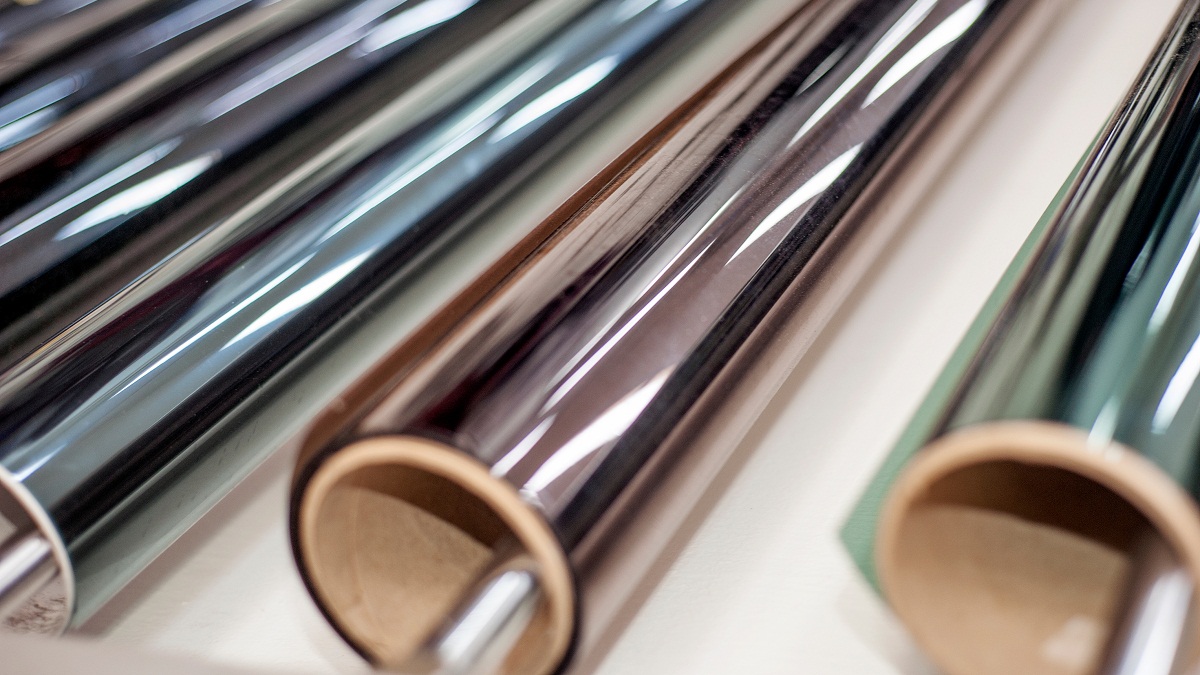Residential and commercial window film is typically made through a manufacturing process that involves several steps. While there may be variations in the exact process among different manufacturers, here is a general overview of how this window film is made:
1) Base Film Production.
The production of the base film begins with raw polyester pellets. The pellets are fed into a hopper and melted at high temperatures, typically around 500°F (260°C). The molten polyester is then forced through a flat die, which has a narrow slit at the bottom. As the polyester flows through the die, it forms a continuous sheet of film. The thickness of the film is controlled by adjusting the gap between the die and the chill roller, where the film solidifies.
2) Coating.
Once the base film is formed, it undergoes a coating process to enhance its performance. Different coatings are applied to achieve specific properties. One common type of coating is a thin layer of metal, such as aluminum or silver, which is deposited onto the film through a process called sputtering. In sputtering, metal atoms are released from a target material and deposited onto the film under vacuum conditions. The metal layer helps to reflect or absorb solar radiation, reducing heat transmission through the window. Other coatings, such as adhesives, UV inhibitors, or scratch-resistant layers, may be applied using various methods like gravure coating, dip coating, or vacuum deposition.
3) Drying and Curing.
After the coatings are applied, the film goes through a drying and curing stage. This step involves passing the film through a series of heated rollers or ovens. The purpose is to remove any solvents or moisture present in the coatings and to promote proper bonding between the coatings and the base film. The specific temperature, dwell time, and number of drying/curing stages depend on the type of film being produced. This process ensures that the film attains the desired optical clarity and performance characteristics.
4) Cutting and Sizing.
Once the film is dried and cured, it is ready to be cut into the desired dimensions. The film may be split into narrower rolls or trimmed into custom sizes, depending on the specific window dimensions and customer requirements. This step is typically carried out using precision cutting machines that can handle the delicate nature of the film without causing damage or distortion.
5) Quality Control.
Quality control inspections are crucial to ensure that the window film meets the manufacturer’s standards. During this stage, the film is carefully inspected for various aspects, such as uniform coating thickness, proper adhesion of coatings to the base film, clarity, and absence of defects like bubbles or scratches. Additional tests may be conducted to assess the film’s performance characteristics, such as its ability to block heat, reduce glare, or provide UV protection. Any film that does not meet the quality standards may be rejected or subjected to corrective measures.
6) Packaging and Distribution.
Once the film passes the quality control stage, it is prepared for packaging and distribution. The film is typically wound onto large rolls or cut into sheets of standardized sizes. The rolls or sheets are then packaged, often with protective layers or liners to prevent damage during transport and storage. The packaging includes labeling with relevant information, such as the type of film, its performance specifications, recommended application areas, and installation instructions. The packaged window film is then ready to be distributed to retailers, contractors, or directly to customers.
In summary.
It is important to note that the specific manufacturing process may vary between different manufacturers and types of window film. Some manufacturers may incorporate additional steps or utilize advanced technologies, such as laminating multiple layers of film or adding specialized coatings for specific functionalities. The goal is to produce high-quality window film that offers desired benefits, such as improved energy efficiency, UV protection, privacy, or decorative effects, while maintaining durability and optical clarity.

